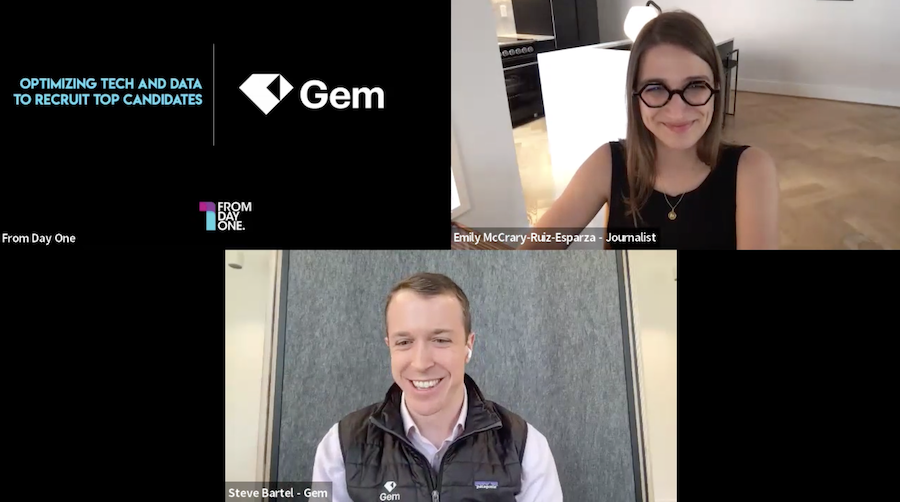Optimizing Tech and Data to Recruit Top Candidates


With every new wave of tech, there comes the fear that it will make some workers obsolete, but when it comes to artificial intelligence eclipsing recruiters, they needn’t worry, said Steve Bartel, CEO and co-founder of AI-powered recruiting platform Gem. “AI is nowhere close to completely replacing jobs. I think for a long time, maybe forever, AI is going to be more of a co-pilot. My read is that AI is going to really speed us up.”
Bartel, whom I spoke to during a From Day One webinar on how employers are using the latest in AI to make hiring more effective and efficient, says there are two reasons AI will help rather than hinder talent acquisition.
First, companies are drowning in applications. “Thirty percent of our customers are seeing 1,000-plus applicants for a [single] job,” he said. Second, at the same time applications are flowing in by the thousands, talent acquisition teams are being asked to do more with less. “They’re being asked to backfill tons of critical roles. As hiring starts to pick up, a lot of recruiting teams are left under-resourced and under-budgeted.”
For overloaded teams, well-deployed AI can be like a rocket booster for recruiting programs, letting humans do what they do best. Artificial intelligence will automate the most manual and painfully tedious parts of the job: for instance, writing the first draft of an outreach email and even personalizing that copy. It can conceive and deliver candidate nurture campaigns that support long-term client relationships. But it can’t fly alone, nor should it. Ultimately, only people can recruit employees into companies.
“A lot of us got into recruiting because we really care about bringing great people into the organization, we really care about forging amazing relationships with candidates,” he said. “AI is not going to be able to replace the human touch. In fact, it’s going to free us up to provide a better candidate experience.”

According to Gem’s own research, 73% of companies today are exploring investment in AI for recruitment automation. A few years ago, the share of employers with such plans was a fraction of that. Directives are coming down from the C-suite, and the imperative is to start using AI–but many still aren’t clear on the use cases or where it’s most beneficial.
At the mercy of vague orders, talent acquisition teams are moving quickly to comply, and they risk making mistakes. The first mistake Bartel sees is not fully vetting a vendor or tech platform; one way to do that is to look under the hood at the information feeding it and the tech powering it.
“A lot of AI demos really well, but when you actually use it in practice, that’s where you run into making pretty silly mistakes, quite honestly,” Bartel said. “Try to run a real trial based on your own data and use cases. Talk to customers to validate that it actually works once you deploy.”
A good recruiting platform also works with your current tech stack. If it doesn’t, recruiters risk cold-contacting current candidates, recent event attendees, or runners-up for interviews. You may end up spamming your existing talent pool, and ultimately damaging your employer brand.
Further, some platforms may be running on outdated information. “A lot of vendors are still on these legacy AI stacks that they’ve invested 10 years into building, but that are suddenly obsolete,” he said.
But recruiters don’t have the time to be bogged down with stale information. “My number-one theory continues to be that recruiting teams are being asked to do more with less and that they’re overworked,” said Bartel. Tech should take a load off the shoulders of recruiting teams. The standard is now a customer-grade candidate experience, and unless talent acquisition is given the room to provide it, recruiting will suffer.
Editor's note: From Day One thanks our partner, Gem, for sponsoring this webinar.
Emily McCrary-Ruiz-Esparza is a freelance journalist and From Day One contributing editor who writes about work, the job market, and women’s experiences in the workplace. Her work has appeared in the Economist, the BBC, The Washington Post, Quartz, Fast Company, and Digiday’s Worklife.
The From Day One Newsletter is a monthly roundup of articles, features, and editorials on innovative ways for companies to forge stronger relationships with their employees, customers, and communities.